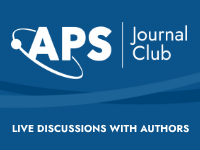| Volume 106, Issue 6 December 2022 | | Advertisement  | PRX Life, APS' newest highly-selective Open Access journal focusing on all aspects of biological organization, has big plans for 2023. Sign up for email alerts to see what the journal is building prior to opening for submissions later this year. Sign up for alerts » | | | | | |
Advertisement | Early bird registration is officially open for March Meeting 2023–one of the largest and most exciting conferences in physics! Witness groundbreaking physics research, network with potential employers, and prepare for career success at March Meeting 2023. Register today » | | | | | | Not an APS member? Join today to start connecting with a community of more than 50,000 physicists. | | | | Editors' Suggestion Valentin Gebhart and Augusto Smerzi Phys. Rev. A 106, 062202 (2022) – Published 2 December 2022  | In a crucial step for securing many existing quantum technologies, the authors use causal diagrams to close the detection loophole in multipartite nonlocality demonstrations. Their results also imply that genuine N-partite nonlocality can be created from N independent photon sources. | | | | | | Editors' Suggestion Lorenzo Leone, Salvatore F. E. Oliviero, Stefano Piemontese, Sarah True, and Alioscia Hamma Phys. Rev. A 106, 062434 (2022) – Published 26 December 2022  | Information can be retrieved from a black hole that is sufficiently scrambling, assuming that the retriever has perfect control of the emitted Hawking radiation and perfect knowledge of the internal dynamics of the black hole. In this paper, the authors show that for black holes modeled by a certain class of random quantum circuits, information can be retrieved by using quantum machine learning to analyze out-of-time-order correlation functions. | | | | | | Editors' Suggestion Wei Wu and Jun-Hong An Phys. Rev. A 106, 062438 (2022) – Published 27 December 2022  | The quantum speed limit quantifies the minimum time it takes for a system to evolve under the constraint of quantum mechanics. Here, the authors investigate the quantum speed limit in a continuous-variable system undergoing non-Markovian noise. Their results imply that this limit may be steerable with the use of spectral engineering. | | | | | | Editors' Suggestion Letter Ilia Tutunnikov, Long Xu, Yehiam Prior, and Ilya Sh. Averbukh Phys. Rev. A 106, L061101 (2022) – Published 8 December 2022  | Efficient molecular orientation at high temperatures is induced by a terahertz pulse with the help of an intense nonresonant laser prepulse that dissects rotational phase space to narrow filaments. The authors use the echo effect to synchronize the terahertz response of all the filaments, leading to much enhanced orientation compared to other techniques. | | | | | | | |


No comments:
Post a Comment